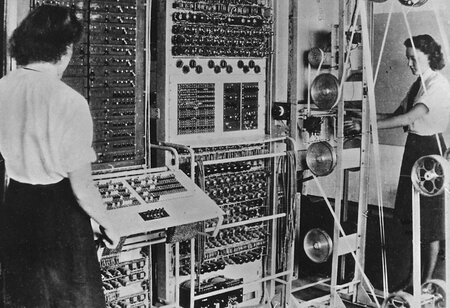British Intelligence Releases Images of WWII Code-Breaking 'Colossus' Computer
By Consultants Review Team
 British intelligence has revealed previously undisclosed images of the groundbreaking 'Colossus' computer, a pivotal element in World War II code-breaking that significantly influenced the Allies' triumph. GCHQ, the UK's intelligence, security, and cyber agency, unveiled the images to commemorate the 80th anniversary of Colossus' inception. The computer, designed by engineer Tommy Flowers, played a crucial role in deciphering coded messages among top Nazi officers. Its impact was particularly notable in misleading Adolf Hitler about the Allies' invasion plans, strategically diverting attention from Normandy to Pas-de-Calais. With 2,500 valves, Colossus was an engineering marvel, recognized as one of the first digital computers.
British intelligence has revealed previously undisclosed images of the groundbreaking 'Colossus' computer, a pivotal element in World War II code-breaking that significantly influenced the Allies' triumph. GCHQ, the UK's intelligence, security, and cyber agency, unveiled the images to commemorate the 80th anniversary of Colossus' inception. The computer, designed by engineer Tommy Flowers, played a crucial role in deciphering coded messages among top Nazi officers. Its impact was particularly notable in misleading Adolf Hitler about the Allies' invasion plans, strategically diverting attention from Normandy to Pas-de-Calais. With 2,500 valves, Colossus was an engineering marvel, recognized as one of the first digital computers.
These newly released images provide an unprecedented glimpse into the genesis and operations of Colossus. Standing over two meters tall, it is considered by many as the pioneer of digital computing. The photographs shed light on the intricate workings of a machine that was shrouded in secrecy until the early 2000s. The complexity and scale of Colossus marked a significant leap in technology for its time, representing a precursor to the computer age.
Recruiting soldiers from the Women's Royal Naval Service (Wrens), large teams of operators and technicians were essential to run and maintain Colossus during its espionage operations against Nazi Germany. Bill Marshall, a former GCHQ engineer who worked on Colossus during the 1960s, emphasized the intense secrecy surrounding the project. Even those working on the machine, including Marshall himself, were kept in the dark about its actual purpose.
Andrew Herbert, a computer scientist and chairman of trustees at The National Museum of Computing, highlighted Colossus' paramount importance in wartime code-breaking. Its ability to decrypt strategic messages passing between German headquarters across Europe was instrumental in the Allies' intelligence efforts.
Housed at the iconic Bletchley Park, where the UK's code-breaking activities were centered, ten Colossus computers, operated by a team of 550 personnel, successfully decrypted a staggering 63 million characters of high-grade German communications by the end of World War II, according to The National Museum of Computing.




